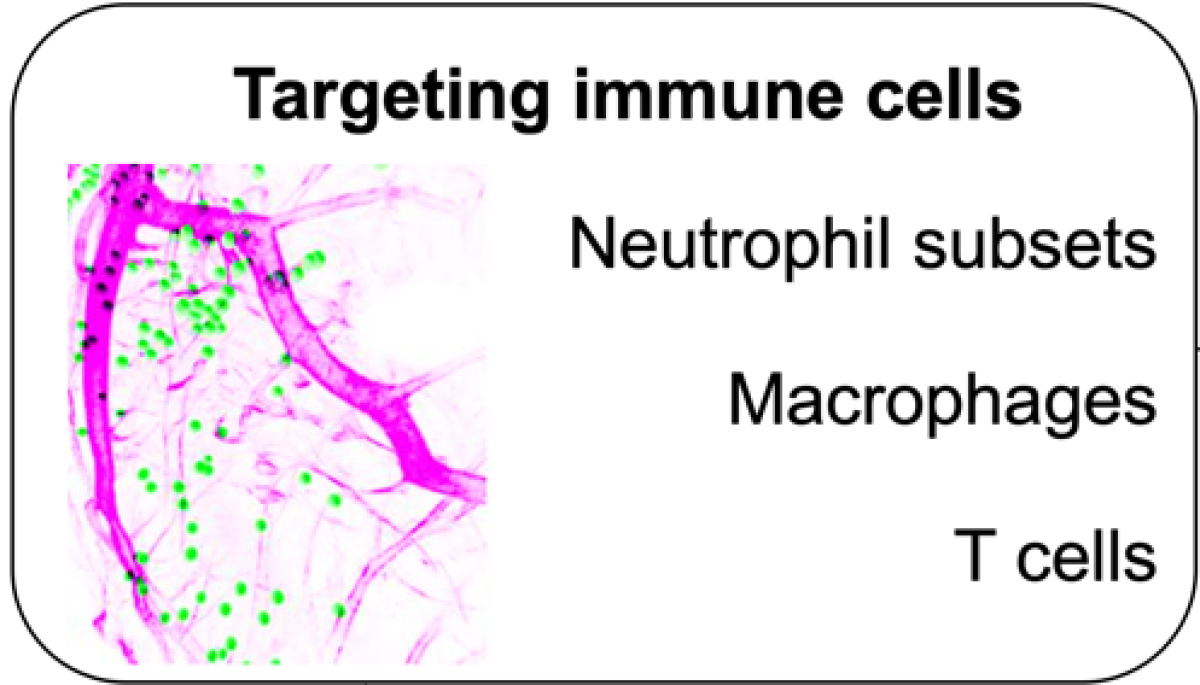Research Area 1: targeting immune cells
The immune system is crucially involved in the regulation of cardiac stress responses. Reperfused acute myocardial infarction induces a complex inflammatory stress response, which is required e.g. for adequate cardiac repair. Neutrophils are rapidly recruited to injured tissues by damage-associated molecular patterns (DAMPs), cytokines and chemokines, activated complement components, and histamines and potentially favor the recruitment of monocytes. Their roles in injury progression and repair have been incompletely studied. Excessive neutrophil activity has been associated with poor prognosis, remodeling, and mortality after AMI. Thus, neutrophils were previously considered to play merely detrimental roles, partly because high neutrophil counts appear to predict poor outcomes for patients with acute coronary syndromes. Experimental data suggest, however, that neutrophils are vital for the clearance of debris, the resolution of inflammation, the regulation of other sets of immune cells, and the return to tissue homeostasis, e.g., by direct interaction with cardiomyocytes. Rather than being undirected, it is now speculated that specific neutrophil subsets can be detected in the myocardium, and their specific roles need to be characterized. However, neutrophils can also improve cardiac function and cardiac repair. It is speculated that this dual role of neutrophils depends on various phenotypes/subsets whose specific roles and location in reperfused myocardial infarction need to be defined.
Macrophages are crucial for multiple steps of the wound-healing response, such as elimination of dead cells. Healing of the myocardium furthermore requires a fine-tuned macrophage response, which is governed by numerous interacting signaling pathways. Initially these macrophages were classified as inflammatory or anti-inflammatory depending on their temporal activities. However, it turned out that macrophages instead exhibit a much broader spectrum of phenotypes that mediate various processes, ranging from cytokine production and phagocytosis to coordination of granulation tissue formation. Their polarization into subsets, location, and specific functionality is still unresolved in reperfused myocardial infarction. The chemokine C-C-chemokine ligand 2 (CCL2) is essential for the migration of inflammatory CCL2+ monocytes into the infarcted tissue. Cardiac-resident C-C-chemokine receptor 2 (CCR2+) macrophages are inflammatory and promote the recruitment of lymphocyte antigen 6 complex (Ly6C)high monocytes, which express CCR2, through CCL2. Recent single-cell RNA sequencing has uncovered three separate subsets of resident macrophage populations and at least seven distinct macrophage subsets within the infarcted heart. Thereby, it has been demonstrated that cardiac tissue-resident CCR2- and CCR2+ macrophages differentially control monocyte recruitment and fate specification in repAMI. Essential upstream mediators of the inflammatory response and adverse left ventricular remodeling in reperfused myocardial infarction are suggested to be the cardiac tissue-resident CCR2+ macrophages. With regard to numerous DAMP signaling pathways, it is not immediately clear which DAMPs and DAMP receptor(s) regulate the activation of cardiac tissue-resident CCR2+ macrophages.
Accumulating evidence suggests that lymphocyte subpopulations also participate in the inflammatory response. For instance, T cells are involved in the modulation of inflammatory responses, thereby adjusting macrophage polarity and autoreactivity. Several studies have demonstrated a high density of lymphoid clusters with elevated T cell numbers in pericardial/epicardial adipose tissue (EAT) in reperfused myocardial infarction. EAT is a visceral fat that surrounds the myocardium and the coronary arteries. It differs from subcutaneous fat and is characterized by smaller adipocyte size, higher fatty acid concentrations, higher content of proteins, and higher insulin-induced lipogenesis, as well as fatty acid breakdown. Epicardial adipose tissue secretes inflammatory mediators such as adiponectin and tumor necrosis factor alpha (TNFα). With increasing amounts of pericardial fat, the balance between pro- and anti-inflammatory mediators shifts towards inflammation. Interestingly, the quantity of dendritic cells and lymphocytes, including T cells in epicardial fat, largely exceeds their numbers in the myocardium after myocardial infarction, at least in preclinical models. Recently, it has been demonstrated that an acute ischemic insult to the heart that results in sterile inflammation, promotes protective T cell autoimmunity in the myocardium of mice. Although the roles of inflammation and T cell responses are quite well characterized in the myocardium in repAMI, the molecular and functional phenotype of T cells and its effect on inflammation of the epicardial adipose tissue and on cardiomyocyte homeostasis still remain elusive.
The specific aims of this Research area are (i) characterization of the distinct neutrophil subsets involved in favorable/detrimental sequelae for cardiomyocyte homeostasis, (ii) identification of how macrophage polarization is regulated and influences cardiomyocyte fate, and (iii) assessment of the modulation of T cell responses by epicardial adipose tissue and its impact on cardiomyocytes. Studies will be performed in experimental approaches and with patients and will be co-supervised by a clinician and a basic science researcher to underscore the general notion of a “bed-to-bench-to-bed” strategy.


